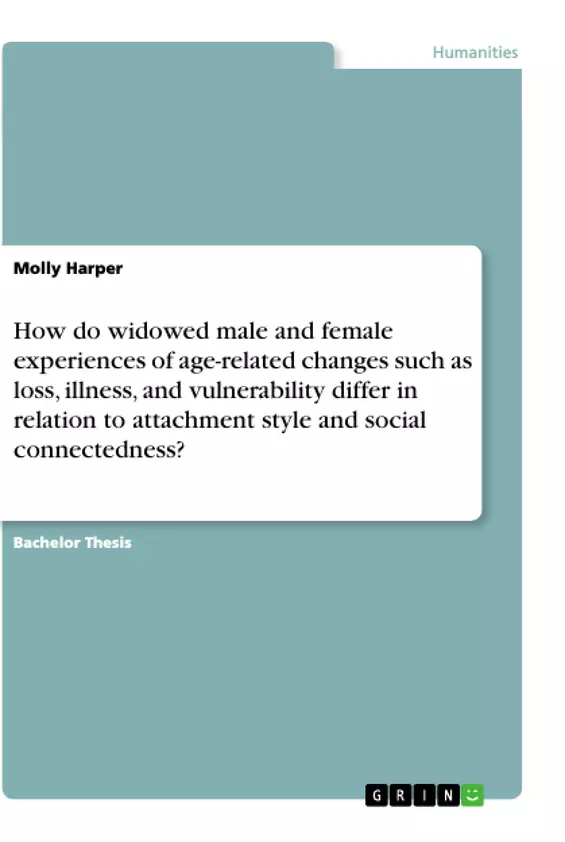Old-age is a time associated with major transitions which can have profound effects on elderly well-being. Research points towards the idea that distinct inter-individual differences exist, like attachment style, which significantly impact adjustment to ageing. The imperative role of these variables paved way for this research as a significant literature gap was revealed. The focus of this study seeks to investigate how widowed elderly male and female experiences of age-related changes such as loss, illness and vulnerability differ in relation to attachment style and social support. Encompassing loss, gender, social support and attachment as a collection of variables which may significantly impact upon well-being, these were translated into research questions to guide analysis.
The sample consisted of participants (n=5) aged 65-80 who were widowed within the last five years. Semi-structured interviews explored the experiences of ageing, while quantitative research measured participant’s attachment style and social network score on the Relationship Questionnaire (Bartholomew and Horowitz, 1991) and Lubben Social Network-6 Scale (Lubben, 1988). Interviews were transcribed and analysed using Interpretive Phenomenological Analysis (IPA), from the perspective of Baltes and Baltes (1990) SOC-model to determine its potential in successful ageing.
This stemmed the emergence of three master themes which encompassed ageing as a drastic transformation, spurring a newfound freedom while entailing loneliness, motivational declines and heightened vulnerabilities. Notable, was the collective dislike of feeling like a ‘burden’. Participant’s performance on attachment and social measures analysed against emergent themes, served as support for the regulating role of social ties and secure-attachment on well-being and satisfaction. The study highlights the benefits of SOC in successfully adjusting to dependencies in the face of declines. Overall, an idiographic exploration of ageing and its impacting variables was established, providing valuable insights and building upon a neglected area which highlights important implications for future research.
Inhaltsverzeichnis (Table of Contents)
- Chapter One.
- 1.1 Introduction.
- 1.2 Background
- 1.3 Researchers Motivation....…….
- 1.4 Aims...........
- 1.5 Objectives..
- Chapter Two
- Literature Review
- 2.1 Introduction
- 2.2 The Impact of Age-Related Changes in Later Life.
- 2.3 Attachment Theory
- 2.5 Attachment and Well-Being.
- 2.6 The Role of Social Support and Attachment in Later Life.
- 2.7 The Impact of Social Support..
- 2.8 Consequences of Widowhood.
- 2.8.1 Loneliness......
- 2.9 Gender Differences in the Experience of Loss.
- 2.10 The Role of Selection, Optimisation and Compensation.......
- 2.11 Conclusion....
- Chapter Three
- Methods...
- 3.1 Design....
- 3.2 Participants.
- 3.2.1 Recruitment.
- 3.2.2 Sample........
- 3.2.3 Inclusion and Exclusion Criteria...
- 3.3 Materials
- 3.3.1 Stage One: Short questionnaires..
- 3.3.1.1 The Relationship Questionnaire..
- 3.3.1.2 The Lubben Social Network Scale..
- 3.3.2 Stage Two: Semi-structured interviews
- 3.4 Procedure..
- 3.5 Analysis
- 3.6 Ethical considerations....
Zielsetzung und Themenschwerpunkte (Objectives and Key Themes)
This study aims to investigate how widowed elderly male and female experiences of age-related changes such as loss, illness and vulnerability differ in relation to attachment style and social support. The study seeks to understand how these factors affect well-being and how individuals adjust to the challenges of aging. * **The Impact of Age-Related Changes:** The study explores how experiences of loss, illness, and vulnerability affect older adults. * **Attachment Style and Social Support:** The study investigates the role of attachment style and social support in influencing well-being and adjustment to aging. * **Gender Differences:** The study examines potential gender differences in the experiences of widowed older adults. * **The Role of Selection, Optimisation and Compensation (SOC):** The study explores how the SOC model may contribute to successful aging. * **Loneliness and Burden:** The study investigates the experience of loneliness and the perception of being a burden among widowed older adults.Zusammenfassung der Kapitel (Chapter Summaries)
Chapter One: Introduction
This chapter introduces the research topic, providing background information on the experiences of widowed elderly individuals and the impact of age-related changes on their well-being. The chapter also outlines the research motivation, aims, and objectives.Chapter Two: Literature Review
This chapter presents a comprehensive review of relevant literature, exploring various concepts such as attachment theory, the impact of age-related changes, the role of social support in later life, the consequences of widowhood, and gender differences in the experience of loss. The chapter concludes with a discussion on the Selection, Optimization, and Compensation model, highlighting its potential in successfully adjusting to age-related changes.Chapter Three: Methods
This chapter outlines the research design, participant recruitment and sampling procedures, materials used in the study, including the Relationship Questionnaire and Lubben Social Network Scale, and the interview process. The chapter concludes with a description of the data analysis techniques and ethical considerations employed in the study.Schlüsselwörter (Keywords)
This study focuses on the experiences of widowed elderly individuals and explores key themes such as age-related changes, attachment style, social support, gender differences, and the role of selection, optimization, and compensation in successful aging. The study utilizes quantitative measures like the Relationship Questionnaire and Lubben Social Network Scale to assess attachment style and social connectedness, and employs Interpretive Phenomenological Analysis (IPA) to interpret interview data and gain insight into the lived experiences of participants.- Citation du texte
- Molly Harper (Auteur), 2019, How do widowed male and female experiences of age-related changes such as loss, illness, and vulnerability differ in relation to attachment style and social connectedness?, Munich, GRIN Verlag, https://www.grin.com/document/703470



